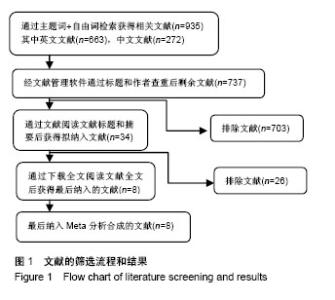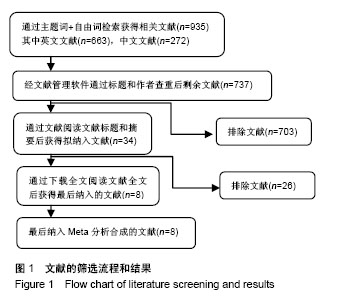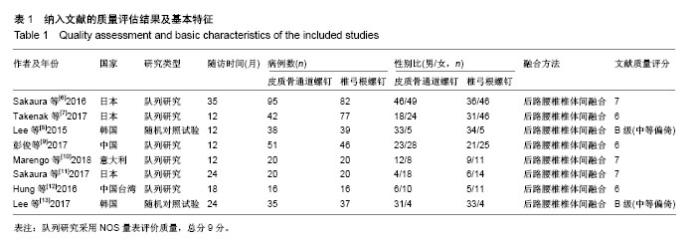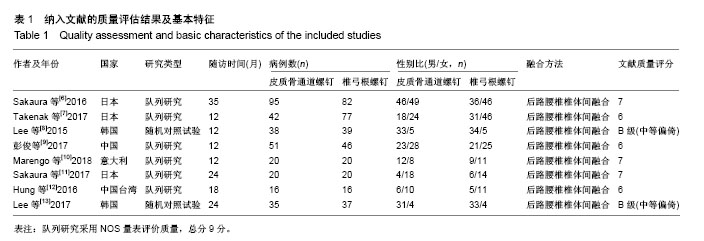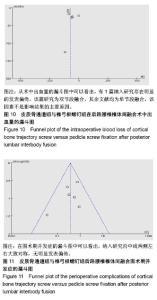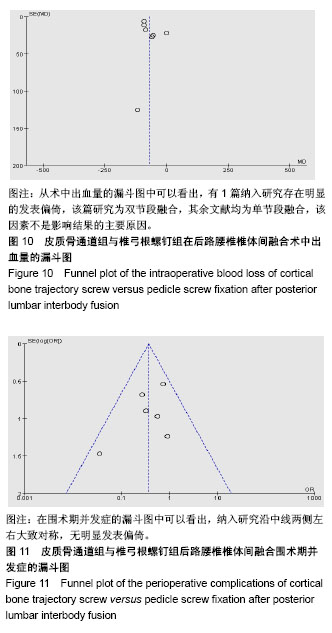Chinese Journal of Tissue Engineering Research ›› 2019, Vol. 23 ›› Issue (8): 1291-1298.doi: 10.3969/j.issn.2095-4344.1089
Previous Articles Next Articles
Cortical bone trajectory screw versus pedicle screw fixation after posterior lumbar interbody fusion: a meta-analysis
Wang Liang, Li Lijun, Zhu Fuliang, Jiang Zhuyan, Wang Shuai, Ni Dongkui
- Department of Orthopedics, the Second Hospital of Tianjin Medical University, Tianjin 300211, China
-
Online:2019-03-18Published:2019-03-18 -
Contact:Ni Dongkui, Chief physician, Department of Orthopedics, the Second Hospital of Tianjin Medical University, Tianjin 300211, China -
About author:Wang Liang, Master candidate, Department of Orthopedics, the Second Hospital of Tianjin Medical University, Tianjin 300211, China -
Supported by:the National Natural Science Foundation of China, No. 81702110 (to LLJ, ZFL, JZY, and WS); the Science and Technology Foundation of Tianjin Health Bureau, No. 2011KZ35 (to LLJ)
CLC Number:
Cite this article
Wang Liang, Li Lijun, Zhu Fuliang, Jiang Zhuyan, Wang Shuai, Ni Dongkui . Cortical bone trajectory screw versus pedicle screw fixation after posterior lumbar interbody fusion: a meta-analysis [J]. Chinese Journal of Tissue Engineering Research, 2019, 23(8): 1291-1298.
share this article
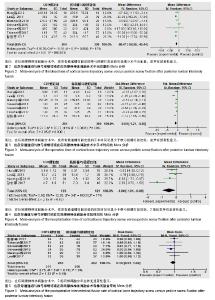
2.2 Meta分析结果 2.2.1 术中出血量 7篇文献比较了后路腰椎椎体间融合术中皮质骨通道螺钉固定跟椎弓根螺钉固定2种固定技术的出血量[6-12];其中皮质骨通道螺钉固定组284例,椎弓根螺钉固定组300例。将此7篇文献数据进行Meta分析,异质性检验结果表明纳入文献间有中度异质性(I2=67%,P=0.006),故采用随机效应模型。合并统计量显示在后路腰椎椎体间融合术中,2种固定方式的出血量差异有显著性意义[MD=-69.47,95%CI(-92.50,46.44),P < 0.000 01]。结果表明,在后路腰椎椎体间融合术中皮质骨通道螺钉固定较椎弓根螺钉固定能明显减少术中出血量,差异有显著性意义,见图2。 2.2.2 手术时间 纳入文献中7篇文献包含后路腰椎椎体间融合术中皮质骨通道螺钉固定与椎弓根螺钉固定2种固定技术的手术时间[6-12],其中皮质骨通道螺钉固定组284例, 椎弓根螺钉固定组300例,进行Meta分析,异质性检验结果表明纳入文献间有明显异质性(I2=80%,P < 0.000 1),故采用随机效应模型,由于纳入文献中手术时间的单位存在小时与分钟,故效应量选用SMD,合并统计量显示在后路腰椎椎体间融合术中,2种固定方式的手术时间差异有显著性意义[SMD=-0.80,95%CI(-1.21,0.39),P=0.000 1]。结果表明,在后路腰椎椎体间融合术中皮质骨通道螺钉固定组的手术时间明显少于椎弓根螺钉固定组,差异有显著性意义,见图3。 2.2.3 住院时间 纳入文献中4篇文献包含后路腰椎椎体间融合术中皮质骨通道螺钉固定与椎弓根螺钉固定2种固定技术的住院时间[8-10,12],其中皮质骨通道螺钉固定组125例,椎弓根螺钉固定组121例,进行Meta分析,异质性检验结果表明纳入文献间有明显异质性(I2=77%,P=0.000 5),故采用随机效应模型,合并统计量显示在后路腰椎椎体间融合术中,2种固定方式的住院时间差异有显著性意义[MD=-1.00,95%CI(-1.91,-0.09),P=0.03]。结果表明,在后路腰椎椎体间融合术中皮质骨通道螺钉固定组的住院时间明显少于椎弓根螺钉固定组,2组间差异有显著性意义,见图4。 2.2.4 椎间融合率 纳入文献中6篇文献包含后路腰椎椎体间融合术中皮质骨通道螺钉固定与椎弓根螺钉固定术后末次随访的椎间融合率[6-7,9-11,13],其中皮质骨通道螺钉固定组265例,椎弓根螺钉固定组282例,进行Meta分析,异质性检验结果表明纳入文献间无异质性(I2=0%,P=0.74),故采用固定效应模型,二分类变量效应指标选用OR,合并统计量显示在后路腰椎椎体间融合术中,2种固定方式的椎间融合率差异无显著性意义[OR=0.96,95%CI(0.91,1.02),P=0.19]。结果表明,在后路腰椎椎体间融合术中皮质骨通道螺钉固定组与椎弓根螺钉固定组比较,2组间椎间融合率差异无显著性意义,见图5。"
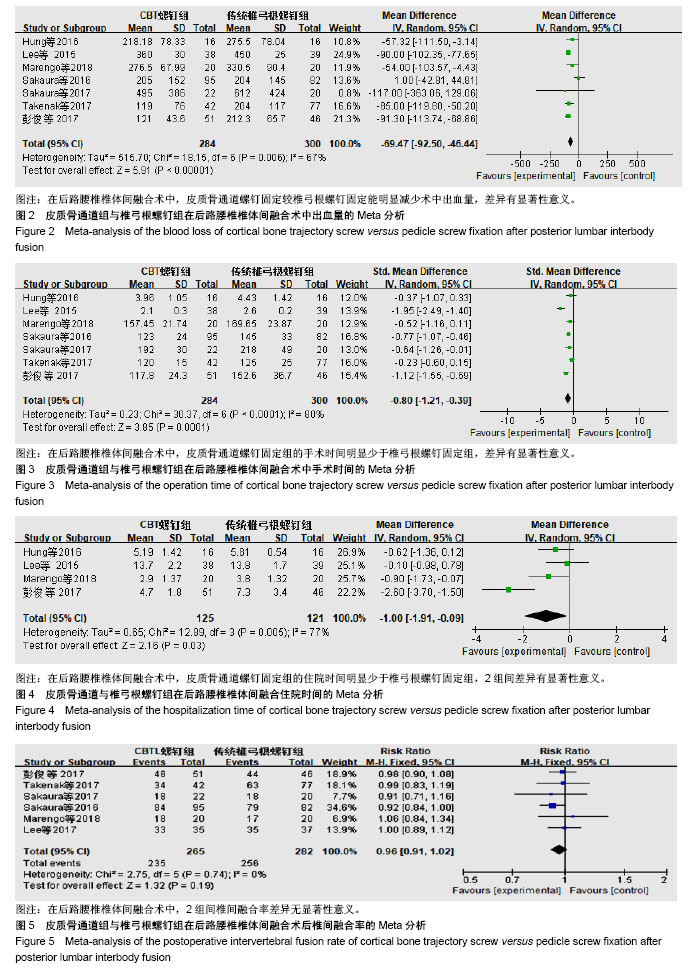
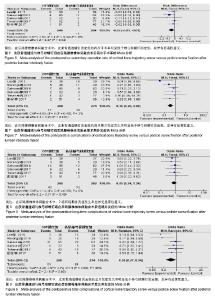
2.2.5 再次手术率 纳入文献中5篇文献包含后路腰椎椎体间融合术中皮质骨通道螺钉固定与椎弓根螺钉固定术后随访期间的再次手术率[6-9,11],其中皮质骨通道螺钉固定组248例,椎弓根螺钉固定组264例,进行Meta分析,异质性检验结果表明纳入文献间无异质性(I2=0%,P=0.42),故采用固定效应模型,二分类变量的效应指标选用OR,合并统计量显示在后路腰椎椎体间融合术中,2种固定方式的再次手术率差异有显著性意义[OR=-0.05,95%CI(-0.09,-0.01),P=0.02]。结果表明,在后路腰椎椎体间融合术中皮质骨通道螺钉固定组的再次手术率明显低于椎弓根螺钉固定组,2组间椎间再次手术率的差异有显著性意义,见图6。 2.2.6 围术期并发症 纳入文献中6篇文献包含后路腰椎椎体间融合术中皮质骨通道螺钉与椎弓根螺钉固定2种固定技术围术期的并发症[6-11],其中皮质骨通道组268例,椎弓根螺钉固定组274例,进行Meta分析,异质性检验结果表明纳入文献间无异质性(I2=2%,P=0.40),故采用固定效应模型,二分类变量效应指标选用OR,合并统计量显示在后路腰椎椎体间融合术中,2种固定方式的围术期并发症差异有显著性意义[OR=0.36,95%CI(0.20,0.68),P=0.001]。结果表明,在后路腰椎椎体间融合术中皮质骨通道螺钉固定组的围术期并发症发生率明显低于椎弓根螺钉固定组,2组间差异有显著性意义,见图7。 2.2.7 远期并发症 纳入文献中6篇文献包含后路腰椎椎体间融合术中皮质骨通道螺钉与椎弓根螺钉固定2种固定技术术的远期并发症[6-7,9-11,13],其中皮质骨通道组265例,椎弓根螺钉固定组282例,进行Meta分析,异质性检验结果表明纳入文献间无异质性(I2=0%,P=0.95),故采用固定效应模型,二分类变量效应指标选用OR,合并统计量显示在后路腰椎椎体间融合术中,2种固定方式的远期并发症差异无显著性意义[OR=0.85,95%CI(0.54,1.34),P=0.48]。结果表明,在后路腰椎椎体间融合术中2组间远期并发症发生率差异无显著性意义,见图8。 2.2.8 总并发症 纳入文献中6篇文献包含后路腰椎椎体间融合术中皮质骨通道螺钉与椎弓根螺钉固定2种固定技术的总并发症[6-11],其中皮质骨通道组268例,椎弓根螺钉固定组274例,进行Meta分析,异质性检验结果表明纳入文献间存在中度异质性(I2=49%,P=0.08),故采用随机效应模型,二分类变量效应指标选用OR,合并统计量显示在后路腰椎椎体间融合术中,2种固定方式的总并发症差异有显著性意义[OR=0.50,95%CI(0.27,0.94),P=0.03]。结果表明,在后路腰椎椎体间融合术中皮质骨通道螺钉固定组的总并发症发生率明显低于椎弓根螺钉固定组,2组间差异有显著性意义,见图9。"
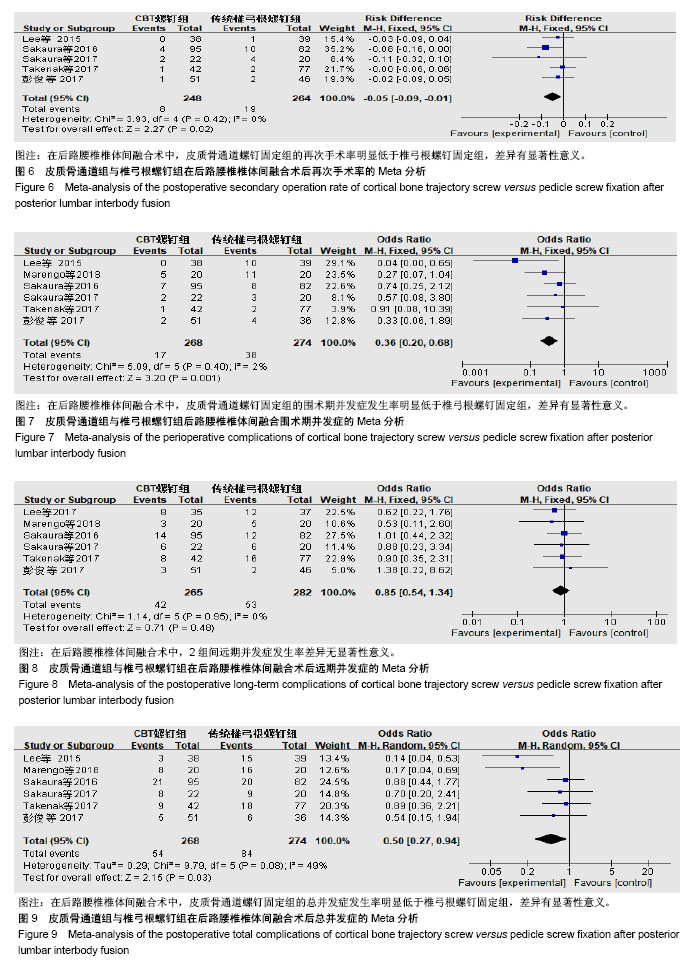
| [1] Cloward RB. The treatment of ruptured lumbar intervertebral discs by vertebral body fusion. I. Indications, operative technique, after care. J Neurosurg. 1953;10(2): 154-168.[2] Santoni BG, Hynes RA, McGilvray KC, et al. Cortical bone trajectory for lumbar pedicle screws. Spine J. 2009;9(5): 366-373.[3] 高海, 李惠民, 陈银河, 等. 皮质骨螺钉固定与椎弓根螺钉固定在腰椎后路融合术中应用效果比较的Meta分析[J]. 中国脊柱脊髓杂志,2017,27(11): 977-984.[4] Keorochana G, Pairuchvej S, Trathitephun W, et al. Comparative Outcomes of Cortical Screw Trajectory Fixation and Pedicle Screw Fixation in Lumbar Spinal Fusion: Systematic Review and Meta-analysis. World Neurosurg. 2017;102: 340-349.[5] Alderson P, Green S, Higgins JP, eds. Cochrane Reviewers' Handbook 4.2.1 [updated December 2003]. Section 6. In: The Cochrane Library. The Cochrane Collaboration. Oxford, 2004. Issue 1.[6] Sakaura H, Miwa T, Yamashita T, et al. Posterior lumbar interbody fusion with cortical bone trajectory screw fixation versus posterior lumbar interbody fusion using traditional pedicle screw fixation for degenerative lumbar spondylolisthesis: a comparative study. J Neurosurg Spine. 2016; 25(5): 591-595.[7] Takenaka S, Mukai Y, Tateishi K, et al. Clinical Outcomes After Posterior Lumbar Interbody Fusion: Comparison of Cortical Bone Trajectory and Conventional Pedicle Screw Insertion. Clin Spine Surg. 2017;30(10): E1411-E1418.[8] Lee GW, Son JH, Ahn MW, et al. The comparison of pedicle screw and cortical screw in posterior lumbar interbody fusion: a prospective randomized noninferiority trial. Spine J. 2015; 15(7): 1519-1526.[9] 彭俊,詹玉林,刘英杰,等. 皮质骨通道螺钉与椎弓根螺钉行腰椎后路椎间融合的疗效比较[J]. 中国修复重建外科杂志, 2017, 31(11): 1341-1345.[10] Marengo N, Ajello M, Pecoraro MF, et al. Cortical Bone Trajectory Screws in Posterior Lumbar Interbody Fusion: Minimally Invasive Surgery for Maximal Muscle Sparing-A Prospective Comparative Study with the Traditional Open Technique. Biomed Res Int. 2018;2018: 7424568.[11] Sakaura H, Miwa T, Yamashita T, et al. Cortical bone trajectory screw fixation versus traditional pedicle screw fixation for 2-level posterior lumbar interbody fusion: comparison of surgical outcomes for 2-level degenerative lumbar spondylolisthesis. J Neurosurg Spine. 2018;28(1): 57-62.[12] Hung CW, Wu MF, Hong RT, et al. Comparison of multifidus muscle atrophy after posterior lumbar interbody fusion with conventional and cortical bone trajectory. Clin Neurol Neurosurg. 2016;145: 41-45.[13] Lee GW, Ahn MW. Comparative Study of Cortical Bone Trajectory-Pedicle Screw (Cortical Screw) Versus Conventional Pedicle Screw in Single-Level Posterior Lumbar Interbody Fusion: A 2-Year Post Hoc Analysis from Prospectively Randomized Data. World Neurosurg. 2018;109: e194-e202.[14] Stevens CD, Dubois RW, Larequi-Lauber T, et al. Efficacy of lumbar discectomy and percutaneous treatments for lumbar disc herniation. Soz Praventivmed. 1997;42(6): 367-379.[15] Rasouli MR, Rahimi-Movaghar V, Shokraneh F, et al. Minimally invasive discectomy versus microdiscectomy/open discectomy for symptomatic lumbar disc herniation. Cochrane Database Syst Rev. 2014;(9): CD010328.[16] Matsukawa K, Yato Y, Kato T, et al. In vivo analysis of insertional torque during pedicle screwing using cortical bone trajectory technique. Spine (Phila Pa 1976). 2014;39(4): E240-245.[17] Kaye ID, Prasad SK, Vaccaro AR, et al. The Cortical Bone Trajectory for Pedicle Screw Insertion. JBJS Rev. 2017;5(8): e13.[18] Rodriguez A, Neal MT, Liu A, et al. Novel placement of cortical bone trajectory screws in previously instrumented pedicles for adjacent-segment lumbar disease using CT image-guided navigation. Neurosurg Focus. 2014;36(3): E9. |
| [1] | Zhang Tongtong, Wang Zhonghua, Wen Jie, Song Yuxin, Liu Lin. Application of three-dimensional printing model in surgical resection and reconstruction of cervical tumor [J]. Chinese Journal of Tissue Engineering Research, 2021, 25(9): 1335-1339. |
| [2] | Chen Junming, Yue Chen, He Peilin, Zhang Juntao, Sun Moyuan, Liu Youwen. Hip arthroplasty versus proximal femoral nail antirotation for intertrochanteric fractures in older adults: a meta-analysis [J]. Chinese Journal of Tissue Engineering Research, 2021, 25(9): 1452-1457. |
| [3] | Chen Jinping, Li Kui, Chen Qian, Guo Haoran, Zhang Yingbo, Wei Peng. Meta-analysis of the efficacy and safety of tranexamic acid in open spinal surgery [J]. Chinese Journal of Tissue Engineering Research, 2021, 25(9): 1458-1464. |
| [4] | Hu Kai, Qiao Xiaohong, Zhang Yonghong, Wang Dong, Qin Sihe. Treatment of displaced intra-articular calcaneal fractures with cannulated screws and plates: a meta-analysis of 15 randomized controlled trials [J]. Chinese Journal of Tissue Engineering Research, 2021, 25(9): 1465-1470. |
| [5] | Huang Dengcheng, Wang Zhike, Cao Xuewei. Comparison of the short-term efficacy of extracorporeal shock wave therapy for middle-aged and elderly knee osteoarthritis: a meta-analysis [J]. Chinese Journal of Tissue Engineering Research, 2021, 25(9): 1471-1476. |
| [6] | Wang Yongsheng, Wu Yang, Li Yanchun. Effect of acute high-intensity exercise on appetite hormones in adults: a meta-analysis [J]. Chinese Journal of Tissue Engineering Research, 2021, 25(8): 1305-1312. |
| [7] | Zeng Yanhua, Hao Yanlei. In vitro culture and purification of Schwann cells: a systematic review [J]. Chinese Journal of Tissue Engineering Research, 2021, 25(7): 1135-1141. |
| [8] | Kong Desheng, He Jingjing, Feng Baofeng, Guo Ruiyun, Asiamah Ernest Amponsah, Lü Fei, Zhang Shuhan, Zhang Xiaolin, Ma Jun, Cui Huixian. Efficacy of mesenchymal stem cells in the spinal cord injury of large animal models: a meta-analysis [J]. Chinese Journal of Tissue Engineering Research, 2021, 25(7): 1142-1148. |
| [9] | Song Chengjie, Chang Hengrui, Shi Mingxin, Meng Xianzhong. Research progress in biomechanical stability of lateral lumbar interbody fusion [J]. Chinese Journal of Tissue Engineering Research, 2021, 25(6): 923-928. |
| [10] | Huang Dengcheng, Wang Zhike, Cao Xuewei. Intravenous, topical tranexamic acid alone or their combination in total knee arthroplasty: a meta-analysis of randomized controlled trials [J]. Chinese Journal of Tissue Engineering Research, 2021, 25(6): 948-956. |
| [11] | Li Yan, Wang Pei, Deng Donghuan, Yan Wei, Li Lei, Jiang Hongjiang. Electroacupuncture for pain control after total knee arthroplasty: a meta-analysis [J]. Chinese Journal of Tissue Engineering Research, 2021, 25(6): 957-963. |
| [12] | He Xiangzhong, Chen Haiyun, Liu Jun, Lü Yang, Pan Jianke, Yang Wenbin, He Jingwen, Huang Junhan. Platelet-rich plasma combined with microfracture versus microfracture in the treatment of knee cartilage lesions: a meta-analysis [J]. Chinese Journal of Tissue Engineering Research, 2021, 25(6): 964-969. |
| [13] | Hua Haotian, Zhao Wenyu, Zhang Lei, Bai Wenbo, Wang Xinwei. Meta-analysis of clinical efficacy and safety of antibiotic artificial bone in the treatment of chronic osteomyelitis [J]. Chinese Journal of Tissue Engineering Research, 2021, 25(6): 970-976. |
| [14] | Zhan Fangbiao, Cheng Jun, Zou Xinsen, Long Jie, Xie Lizhong, Deng Qianrong. Intraoperative intravenous application of tranexamic acid reduces perioperative bleeding in multilevel posterior spinal surgery: a meta-analysis [J]. Chinese Journal of Tissue Engineering Research, 2021, 25(6): 977-984. |
| [15] | Xu Dongzi, Zhang Ting, Ouyang Zhaolian. The global competitive situation of cardiac tissue engineering based on patent analysis [J]. Chinese Journal of Tissue Engineering Research, 2021, 25(5): 807-812. |
| Viewed | ||||||
|
Full text |
|
|||||
|
Abstract |
|
|||||
